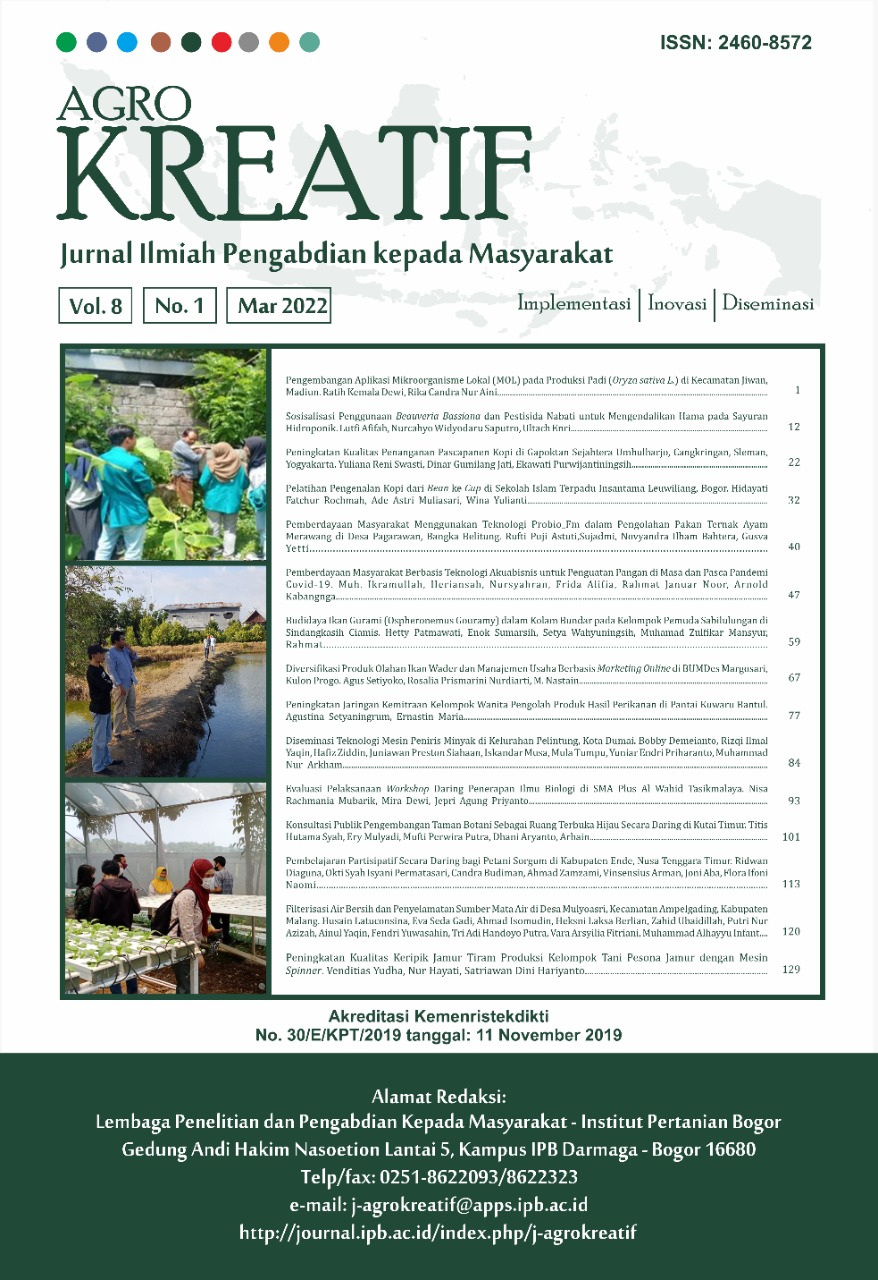Peningkatan Kualitas Penanganan Pascapanen Kopi di Gapoktan Sejahtera Umbulharjo, Cangkringan, Sleman, Yogyakarta
DOI:
https://doi.org/10.29244/agrokreatif.8.1.22-31Keywords:
coffee farmer; farmers union; postharvest coffee handlingAbstract
The coffee farmers of Farmer Union (Gapoktan) Sejahtera Umbulharjo had a lack of knowledge of good coffee post-harvest handling such as the best harvesting time, fermentation, drying, roasting green been extracting, and packaging roasted coffee need to be improved through extension and training postharvest handing. This research aimed to improve the quality of the coffee postharvest handling. The methods employed are extension and training. The result showed the increase of Gapoktan farmers’ understanding, especially in harvesting technique (pre-test score 33,33 and post-test score 93,33) and drying coffee (pre-test score 44,44 and post-test score 100). In addition, the improvement of postharvest handling reduced the drying time from 30 days to 14 days.
Downloads
References
Abubakar Y, Hasni D, Muzaifa M, Sulaiman, Mahdi, Widayat HP. 2019. Effect of varieties and processing practices on the physical and sensory characteristics of Gayo Arabica specialty coffee. IOP Conference Series: Materials Science and Engineering. 523(1): 1‒9. https://doi.org/10.1088/1757-899X/523/1/012027
Chaplin SB, Manske JM. 2005. A Theme-Based Approach to Teaching Nonmajors Biology: Helping Students Connect Biology to Their Lives. Journal of College Science Teaching. 35(1): 47‒51.
Chilosi G, Aleandri MP, Luccioli E, Stazi SR, Marabottini R, Morales-Rodríguez C, Vettraino AM, Vannini A. 2020. Suppression of soil-borne plant pathogens in growing media amended with espresso spent coffee grounds as a carrier of Trichoderma spp. Scientia Horticulturae. 259(2020): 1‒7. https://doi.org/10.1016/j.scienta.2019.108666
de Melo Pereira GV, Neto DPC, Júnior AIM, Vásquez ZS, Medeiros ABP, Vandenberghe LPS, Soccol CR. 2019. Exploring the impacts of postharvest processing on the aroma formation of coffee beans – A review. Food Chemistry. 272: 441‒452. https://doi.org/10.1016/j.foodchem.2018.08.061
Frisullo P, Laverse J, Barnabà M, Navarini L, Nobile MA. 2012. Coffee beans microstructural changes induced by cultivation processing: An X-ray microtomographic investigation. Journal of Food Engineering. 109(1): 175–181. https://doi.org/10.1016/j.jfoodeng.2011.09.015.
Gall MD, Gall JP, Borg WR. 2007. Educational Research: An Introduction. 8th Edition. Boston (US): Allyn and Bacon (p. 683). https://doi.org/10.4324/9781003008064-1
Ghosh P, Venkatachalapathy N. 2014. Processing and Drying of Coffee - A review. International Journal of Engineering Research & Technology, 3(12): 784–794.
Hu G, Peng X, Wang X, Li X, Li X, Qiu M. 2020. Excavation of coffee maturity markers and further research on their changes in coffee cherries of different maturity. Food Research International. 132: (1‒7). https://doi.org/10.1016/j.foodres.2020.109121
Kulapichitr F, Borompichaichartkul C, Suppavorasatit I, Cadwallader KR. 2019. Impact of drying process on chemical composition and key aroma components of Arabica coffee. Food Chemistry. 291: 49‒58. https://doi.org/10.1016/j.foodchem.2019.03.152
Lamberti M, Escher F. 2007. Aluminium foil as a food packaging material in comparison with other materials. Food Reviews International. 23(4): 407–433. https://doi.org/10.1080/87559120701593830
Lee LW, Cheong MW, Curran P, Yu B, Liu SQ. 2015. Coffee fermentation and flavor - An intricate and delicate relationship. Food Chemistry. 185: 182–191. https://doi.org/10.1016/j.foodchem.2015.03.124.
Martinez SJ, Bressani APP, Dias DR, Simão JBP, Schwan RF. 2019. Effect of bacterial and yeast starters on the formation of volatile and organic acid compounds in coffee beans and selection of flavors markers precursors during wet fermentation. Frontiers in Microbiology. 10: 1‒13. https://doi.org/10.3389/fmicb.2019.01287
Maulana AE, Effendi I. 2020. Pelatihan Komunikasi Daring yang Efektif bagi Anggota Asosiasi Pengusaha Patin UKM Indonesia. Agrokreatif Jurnal Ilmiah Pengabdian Kepada Masyarakat. 6(3): 260268. https://doi.org/10.29244/agrokreatif.6.3.260-268
Münchow M, Alstrup J, Steen I, Giacalone D. 2020. Roasting Conditions and Coffee Flavor: A Multi-Study Empirical Investigation. Beverages. 6(29): 1‒14. https://doi.org/10.3390/beverages6020029
Preedy VR. 2015. Coffee in Health and Disease Prevention. London (US): Academic Press.
Ren Y, Wang C, Xu J, Wang S. 2019. Cafestol and kahweol: A review on their bioactivities and pharmacological properties. International Journal of Molecular Sciences. 20(17): 1‒15. https://doi.org/10.3390/ijms20174238
Sobari I, Purwanto H. 2012. Pengaruh Jenis Tanaman Penaung terhadap Pertumbuhan dan Persentase Tanaman Berbuah pada Kopi Arabika Varietas Kartika 1. 3(3): 217–222.
Sugiyono. 2019. Metode Penelitian Kuantitatif, Kualitatif, dan R&D. Bandung (ID): Penerbit Alfabeta.
Vignoli JA, Viegas MC, Bassoli DG, Benassi MT. 2014. Roasting process affects differently the bioactive compounds and the antioxidant activity of arabica and robusta coffees. Food Research International, 61: 279–285. https://doi.org/10.1016/j.foodres.2013.06.006
Wang X, Lim LT. 2014. Effect of roasting conditions on carbon dioxide degassing behavior in coffee. Food Research International. 61: 144–151. https://doi.org/10.1016/j.foodres.2014.01.027
Wang X, Lim LT. 2017. Investigation of CO2 precursors in roasted coffee. Food Chemistry. 219: 185–192. https://doi.org/10.1016/j.foodchem.2016.09.095
Wintgens JN. 2004. Coffee: Growing, Processing, Sustainable Production. New Jersey (US): Wiley. https://doi.org/10.1002/9783527619627
Yılmaz B, Acar-Tek N, Sözlü S. 2017. Turkish cultural heritage: a cup of coffee. Journal of Ethnic Foods. 4(4): 213–220. https://doi.org/10.1016/j.jef.2017.11.003
Downloads
Published
Issue
Section
License
This work is licensed under a Creative Commons Attribution-NonCommercial 4.0 International License.










